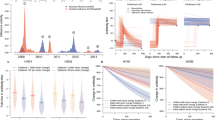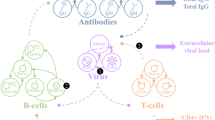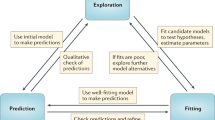Abstract
FOR some time it has been thought that the generation of antibody-forming cells (AFC) may involve an interaction between cell types1–3. We present here a stochastic model, based on a two-cell interaction system, for the production of AFC. The assumptions on which the model is based have chiefly come from an interpretation of two types of experimental data, each of which can yield information concerning the number of cells involved. The first is limiting dilution analysis, which is based on the Poisson probability distribution. The second is dose–response analysis, showing the relationship between lymphoid cell dose and the number of AFC generated. These types of experiments involve either the transfer of lymphoid cells to irradiated, compatible recipients or the growth of lymphoid cells in diffusion chamber cultures.
This is a preview of subscription content, access via your institution
Access options
Subscribe to this journal
Receive 51 print issues and online access
$199.00 per year
only $3.90 per issue
Buy this article
- Purchase on Springer Link
- Instant access to full article PDF
Prices may be subject to local taxes which are calculated during checkout
Similar content being viewed by others
References
Fishman, M., Nature, 183, 1200 (1959).
Mosier, D. E., Science, 158, 1573 (1967).
Davies, A. J. S., Leuchars, E., Wallis, V., Marchant, R., and Elliott, E. V., Transplantation, 5, 222 (1967).
Brown, R. A., Makinodan, T., and Albright, J. F., Nature, 210, 1383 (1966).
Kennedy, J. C., Till, J. E., Siminovitch, L., and McCulloch, E. A., J. Immunol., 96, 973 (1966).
Bosma, M. J., Makinodan, T., and Walburg, jun., H. E., J. Immunol., 99, 420 (1967).
Groves, D. L., Fed. Proc., 27, 318 (1968).
Perkins, E. H., Robinson, M. A., and Makinodan, T., J. Immunol., 86, 533 (1961).
Makela, O., and Mitchison, N. A., Immunology, 8, 539 (1965).
Santos, G. W., and Owens, jun., A. H., Bull. Johns Hopkins Hosp., 118, 109 (1966).
Albright, J. F., and Makinodan, T., in Molecular and Cellular Basis of Antibody Formation (edit. by Sterzl, J., et al.), 427 (Academic Press, New York, 1965).
Bosma, M. J., Perkins, E. H., and Makinodan, T., J. Immunol., 101, 963 (1968).
Celada, F., J. Exp. Med., 125, 199 (1967).
Bussard, A. E., and Lurie, M., J. Exp. Med., 125, 873 (1967).
Gregory, C. J., and Lajtha, L. G., Nature, 218, 1079 (1968).
Luzzati, A. L., Tosi, R. M., Carbonara, A. O., and Ceppellini, R., Atti Ass. Genet. Ital., 13, 239 (1968).
Author information
Authors and Affiliations
Rights and permissions
About this article
Cite this article
GROVES, D., LEVER, W. & MAKINODAN, T. Stochastic Model for the Production of Antibody-forming Cells. Nature 222, 95–97 (1969). https://doi.org/10.1038/222095a0
Received:
Revised:
Issue Date:
DOI: https://doi.org/10.1038/222095a0
Comments
By submitting a comment you agree to abide by our Terms and Community Guidelines. If you find something abusive or that does not comply with our terms or guidelines please flag it as inappropriate.



